Improving the On-Line Extraction of Polar Compounds by IT-SPME with Silica Nanoparticles Modified Phases
Abstract
:1. Introduction
2. Materials and Methods
2.1. Chemicals
2.2. Apparatus and Chromatographic Conditions
2.3. Preparation of the TEOS-METEOS Coated Capillaries
2.4. IT-SPME Conditions
2.5. Analysis of Environmental Samples
3. Results
3.1. Study of the Extraction Efficiencies
3.2. Analytical Parameters
3.3. Application to Environmental Samples
4. Discussion
5. Conclusions
Acknowledgments
Author Contributions
Conflicts of Interest
References and Notes
- Kuster, M.; López de Alda, M.; Barceló, D. Liquid chromatography-tandem mass spectrometric analysis and regulatory issues of polar pesticides in natural and treated waters. J. Chromatogr. A 2009, 1216, 520–529. [Google Scholar] [CrossRef] [PubMed]
- Moliner-Martínez, Y.; Herráez-Hernández, R.; Verdú-Andrés, J.; Molins-Legua, C.; Campíns-Falcó, P. Recent advances of in-tube solid phase microextraction. Trends Anal. Chem. 2015, 71, 205–213. [Google Scholar] [CrossRef]
- Serra-Mora, P.; Moliner-Martínez, Y.; Molins-Legua, C.; Herráez-Hernández, R.; Verdú-Andrés, J.; Campíns-Falcó, P. Trends in online in-tube solid phase microextraction. In Comprehensive Analytical Chemistry; Elsevier: Amsterdam, The Netherlands, 2017; pp. 427–461. ISSN 0166-526X. [Google Scholar]
- Wen, Y.; Chen, L.; Li, J.; Liu, D.; Chen, L. Recent advances in solid-phase sorbents for sample preparation prior to chromatographic analysis. Trends Anal. Chem. 2014, 59, 26–41. [Google Scholar] [CrossRef]
- Fumes, B.H.; Silva, M.R.; Andrade, F.N.; Nazario, C.E.D.; Lanças, F.M. Recent advances and future trends in new materials for sample preparation. Trends Anal. Chem. 2015, 71, 9–25. [Google Scholar] [CrossRef]
- Xu, L.; Qi, X.; Li, X.; Bai, Y.; Liu, H. Recent advances in applications of nanomaterials for sample preparation. Talanta 2016, 146, 714–726. [Google Scholar] [CrossRef] [PubMed]
- Moliner-Martínez, Y.; Serra-Mora, P.; Verdú-Andrés, J.; Molins-Legua, C.; Herráez-Hernández, R.; Campíns-Falcó, P. Application of nanomaterials in solid and liquid microextraction. In Analytical Microextraction Techniques Basel, Switzerland; Bentham Science Publishers: Sharjah, UAE, 2016; pp. 135–166. [Google Scholar]
- Lin, B.; Li, T.; Zhao, Y.; Huang, F.-K.; Guo, L.; Feng, Y.-Q. Preparation of a TiO2 nanoparticle-deposited capillary column by liquid phase deposition and its application in phosphopeptide analysis. J. Chromatogr. A 2008, 1192, 95–102. [Google Scholar] [CrossRef] [PubMed]
- Yu, Q.-W.; Ma, Q.; Feng, Y.-Q. Temperature-response polymer coating for in-tube solid-phase microextraction coupled to high-performance liquid chromatography. Talanta 2011, 84, 1019–1025. [Google Scholar] [CrossRef] [PubMed]
- Moliner-Martínez, Y.; Prima-García, H.; Ribera, A.; Coronado, E.; Campíns-Falcó, P. Magnetic in-tube solid phase microextraction. Anal. Chem. 2012, 84, 7233–7240. [Google Scholar] [CrossRef] [PubMed]
- González-Fuenzalida, R.A.; Moliner-Martínez, Y.; Prima-Garcia, H.; Ribera, A.; Campíns-Falcó, P.; Zaragozá, R.J. Evaluation of superparamagnetic silica nanoparticles for extraction of triazines in magnetic in-tube solid phase microextraction coupled to capillary liquid chromatography. Nanomaterials 2014, 4, 242–255. [Google Scholar] [CrossRef]
- Jornet-Martínez, N.; Serra-Mora, P.; Moliner-Martínez, Y.; Herráez-Hernández, R.; Campíns-Falcó, P. Evaluation of carbon nanotubes functionalized polydimethylsiloxane based coatings for in-tube solid phase microextraction coupled to capillary liquid chromatography. Chromatography 2015, 2, 515–528. [Google Scholar] [CrossRef]
- Moliner-Martínez, Y.; Serra-Mora, P.; Verdú-Andrés, J.; Herráez-Hernández, R.; Campíns-Falcó, P. Analysis of polar triazines and degradation products in waters by in-tube solid-phase microextraction and capillary chromatography: An environmentally friendly method. Anal. Bioanal. Chem. 2015, 407, 1485–1497. [Google Scholar] [CrossRef] [PubMed]
- Argente-García, A.I.; Moliner-Martínez, Y.; López-García, E.; Campíns-Falcó, P.; Herráez-Hernández, R. Application of carbon nanotubes modified coatings for the determination of amphethamines by in-tube solid-phase microextraction and capillary liquid chromatography. Separations 2016, 3, 7. [Google Scholar] [CrossRef]
- Serra-Mora, P.; Jornet-Martínez, N.; Moliner-Martínez, Y.; Campíns-Falcó, P. In tube-solid phase microextraction-nano liquid chromatography: Application to the determination of intact and degraded polar triazines in waters and recovered struvite. J. Chromatogr. A 2017, 1513, 51–58. [Google Scholar] [CrossRef] [PubMed]
- International Union of Pure and Applied Chemistry (IUPAC). Global Availability of Information on Agrochemicals. Available online: http://old.iupac.org (accessed on 19 January 2018).
- European Commission. Health and Consumer Protection Directorate-General on Tritosulfuron. 20 May 2008.
- NIH Open Chemistry Database. Available online: https://pubchem.ncbi.nlm.nih.gov/ (accessed on 19 January 2018).
- Irgarol 1051 Material Safety Data Sheet, Ciba Corporation, Tarrytown, NY, USA (revised on 29 October 2008).
- Wang, Z.; Xiao, C.; Wu, C.; Han, H. High-performance polyethylene glycol-coated solid-phase microextraction fibers using sol-gel technology. J. Chromatogr. A 2000, 893, 157–168. [Google Scholar] [CrossRef]
- Silva, R.G.G.; Augusto, F. Highly porous solid-phase microextraction fiber coating based on poly(ethylene glycol)-modified ormosil synthesized by sol-gel technology. J. Chromatogr. A 2005, 1072, 7–12. [Google Scholar] [CrossRef]
- Ou, J.; Lin, H.; Zhang, Z.; Huang, G.; Dong, J.; Zou, H. Recent advances in preparation and application of hybrid organic-silica monolithic capillary columns. Electrophoresis 2013, 34, 126–140. [Google Scholar] [CrossRef] [PubMed]
- Patwardhan, S.V.; Emami, F.S.; Berry, R.J.; Jones, S.E.; Naik, R.R.; Deschaume, O.; Heinz, H.; Perry, C.C. Chemistry of aqueous silica nanoparticle surfaces and the mechanism of selective peptide adsorption. J. Am. Chem. Soc. 2012, 134, 6244–6258. [Google Scholar] [CrossRef] [PubMed]
- Bapat, G.; Labade, C.; Chaudhari, A.; Zinjarde, S. Silica nanoparticle based techniques for extraction, detection and degradation of pesticides. Adv. Colloid Interface Sci. 2016, 237, 1–14. [Google Scholar] [CrossRef] [PubMed]
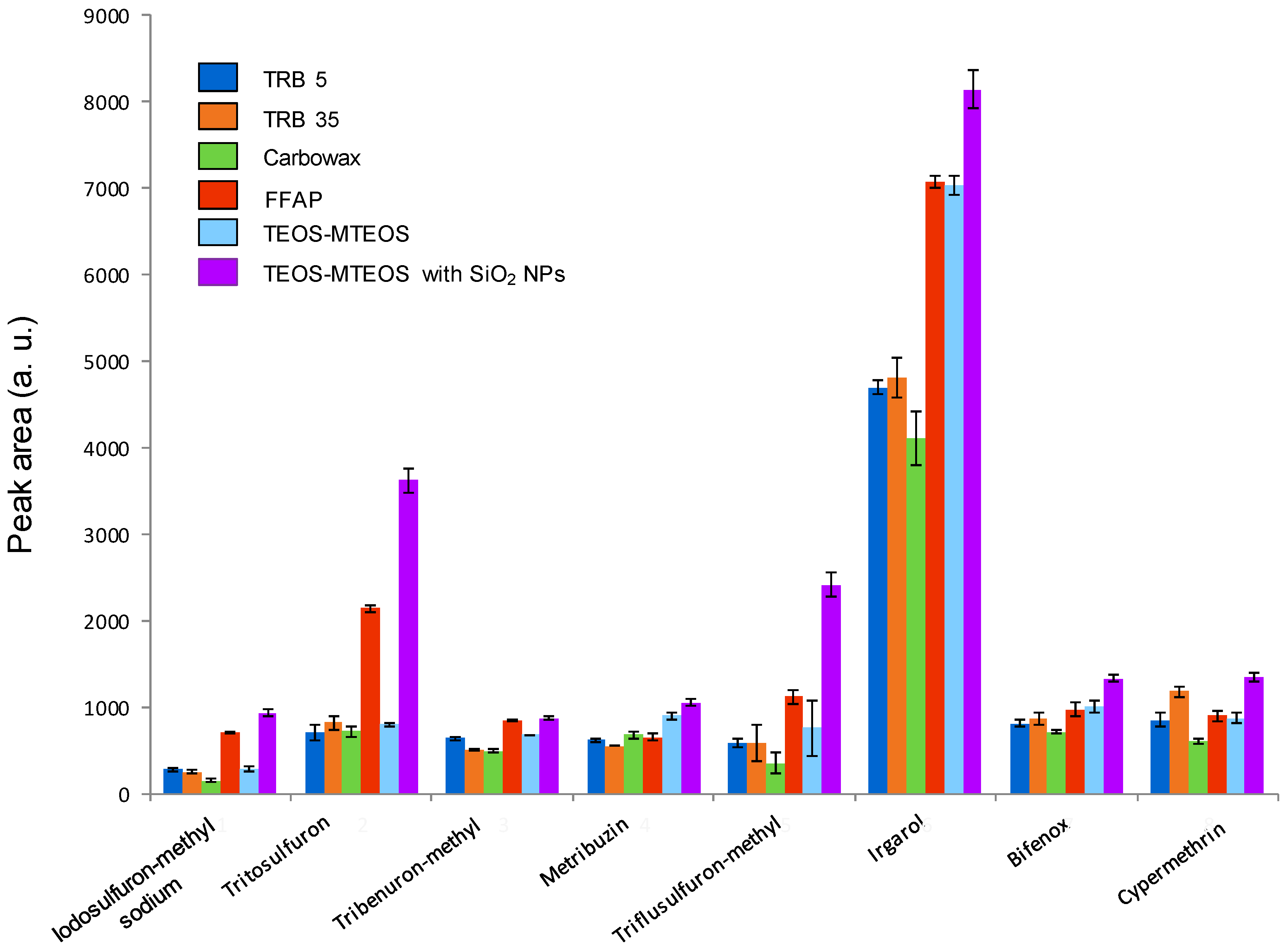
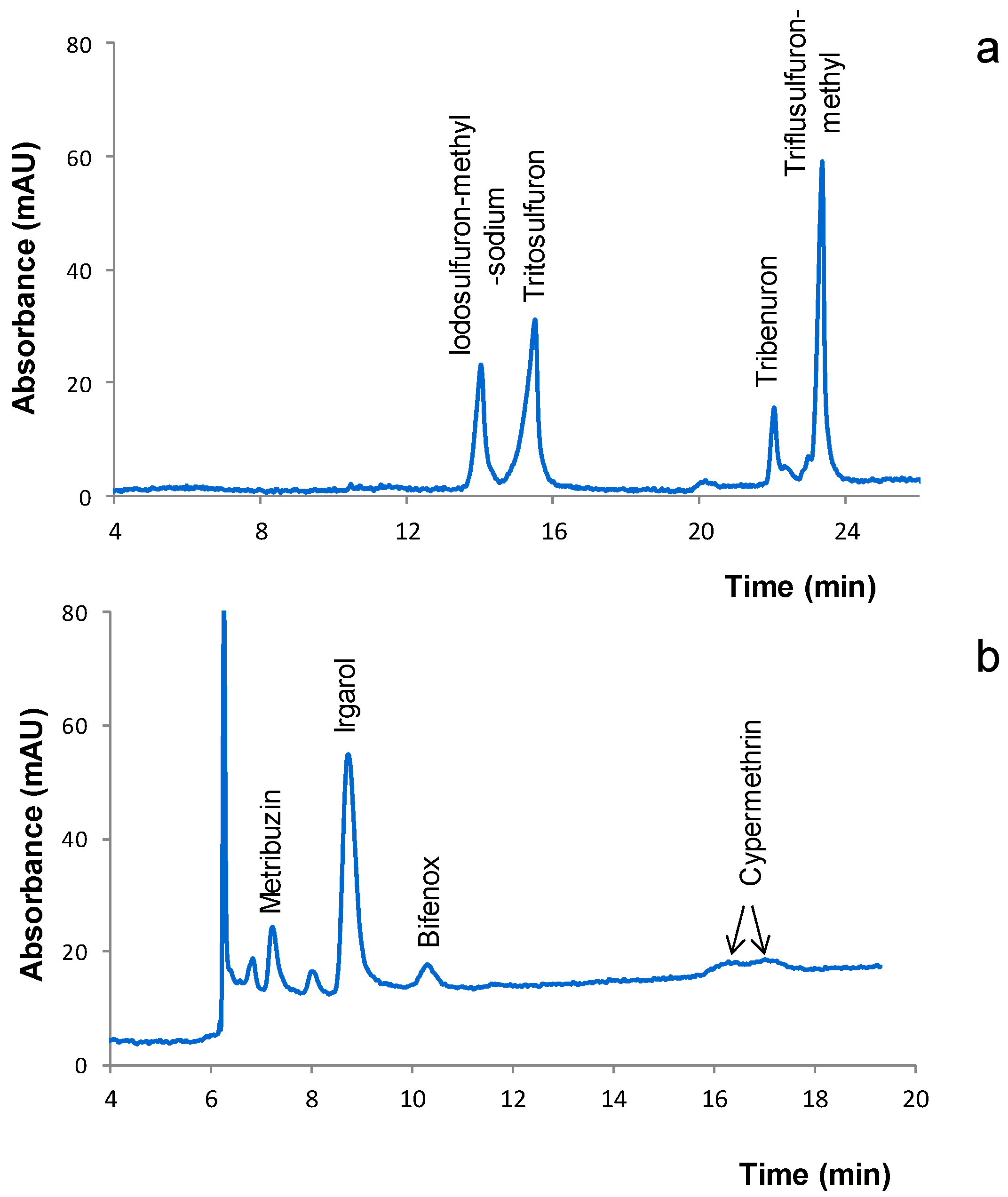
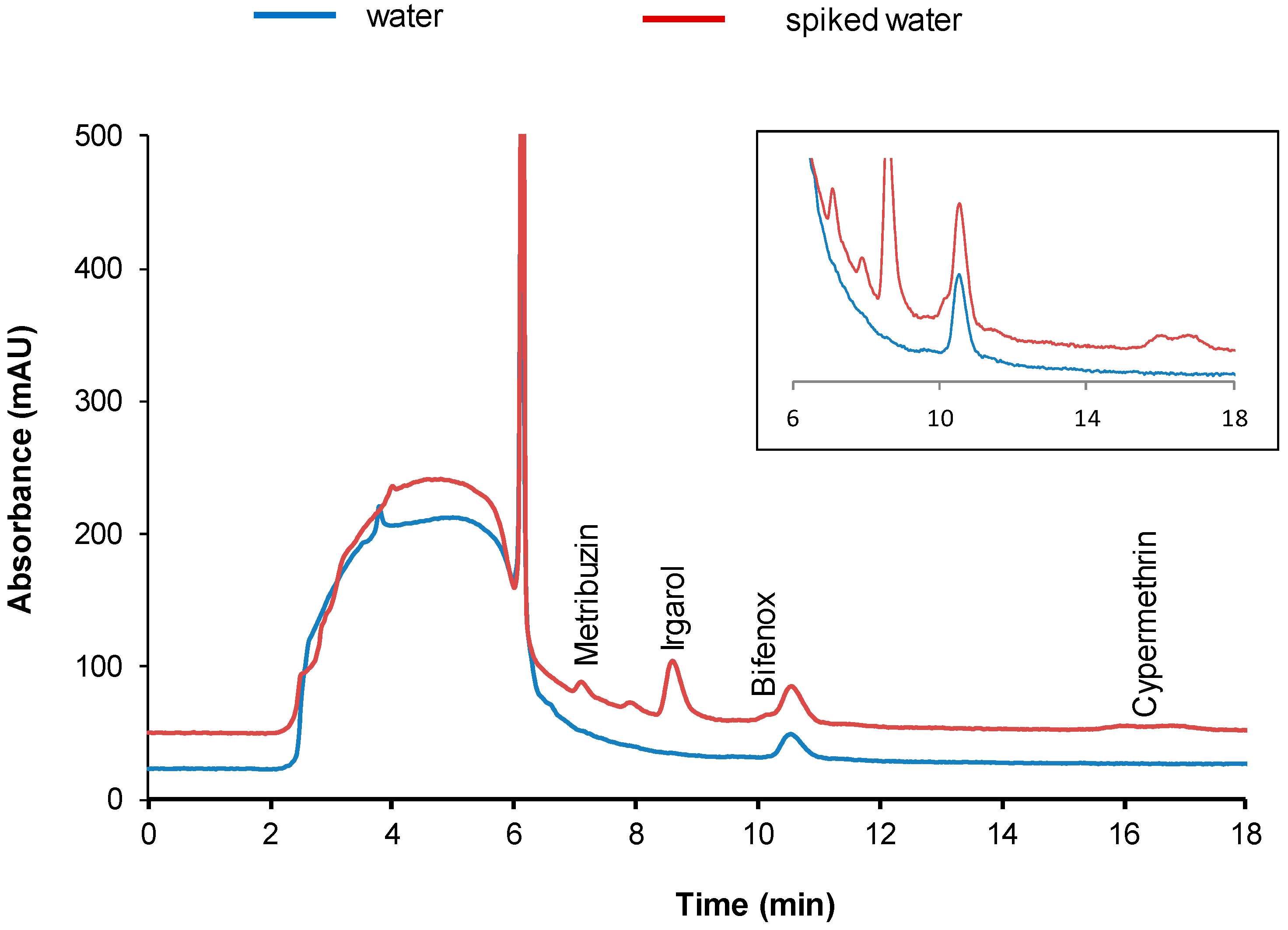
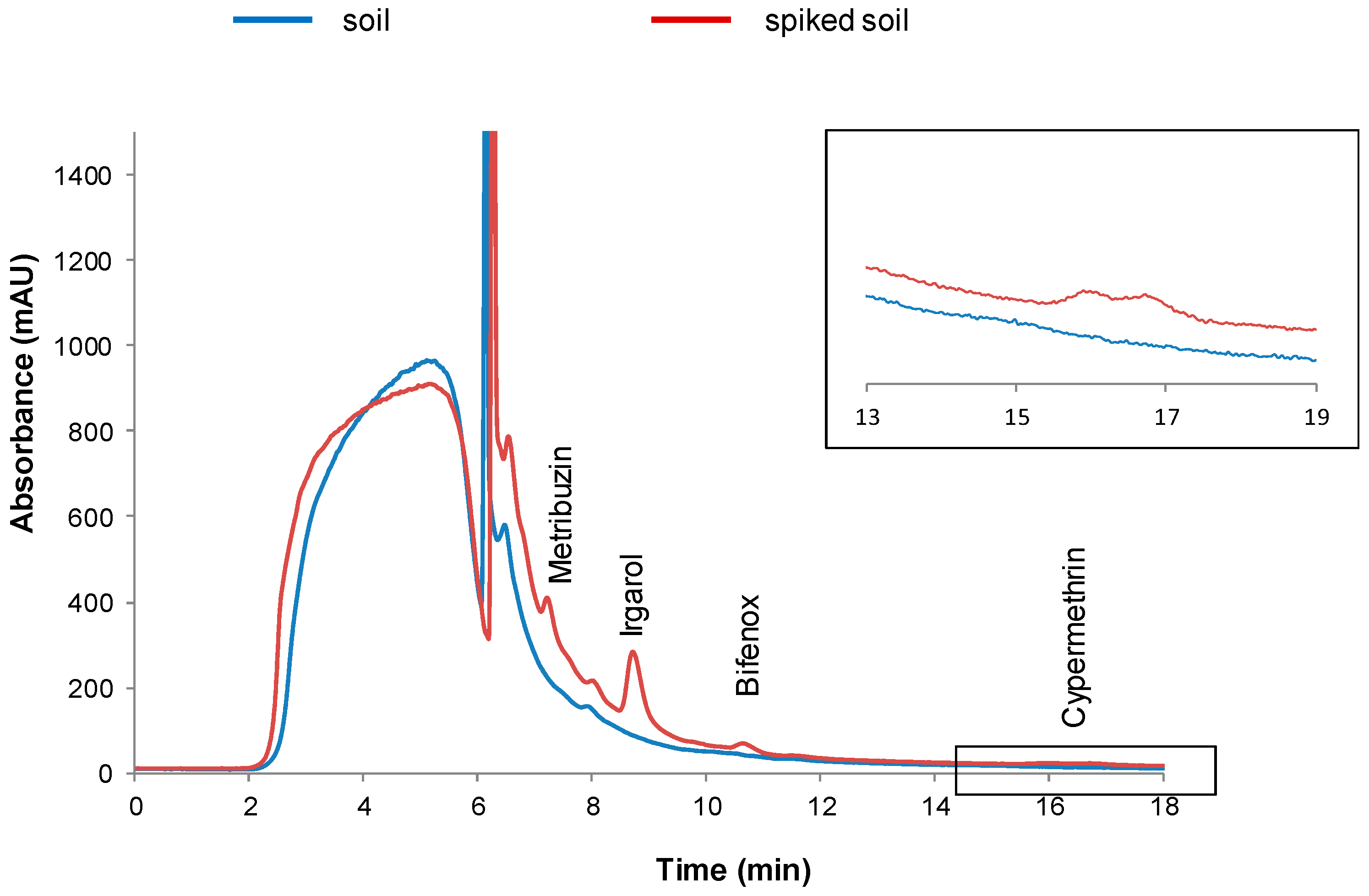
| Compound | TRB 35 | Log Kow | Reference |
|---|---|---|---|
| Iodosulfuron-methyl-sodium |  | −0.7 | [16] |
| Tritosulfuron | 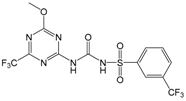 | 0.6 | [17] |
| Tribenuron-methyl |  | 0.8 | [18] |
| Metribuzin |  | 1.7 | [18] |
| Triflusulfuron-methyl |  | 3.1 | [16] |
| Irgarol |  | 3.1 | [19] |
| Bifenox |  | 4.4 | [18] |
| Cypermethrin |  | 6.6 | [18] |
| Extractive Phase | Structure | |
|---|---|---|
| PDMS 1 | 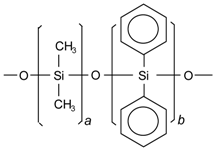 | |
| PEG |  | |
| FFAP | ||
| TEOS-MTEOS |  | |
| Compound/ER | TRB 35 | PEG | FFAP | TEOS-MTEOS | TEOS-MTEOS with SiO2 NPs |
|---|---|---|---|---|---|
| Iodosulfuron-methyl-sodium | 0.90 ± 0.09 | 0.55 ± 0.08 | 2.5 ± 0.2 | 1.0 ± 0.1 | 3.3 ± 0.02 |
| Tritosulfuron | 1.1 ± 0.2 | 1.0 ± 0.1 | 3.0 ± 0.4 | 1.1 ± 0.1 | 5.1 ± 0.6 |
| Tribenuron-methyl | 0.79 ± 0.03 | 0.77 ± 0.04 | 1.8 ± 0.1 | 1.06 ± 0.03 | 3.8 ± 0.1 |
| Metribuzin | 0.90 ± 0.02 | 1.10 ± 0.07 | 1.06 ± 0.07 | 1.46 ± 0.07 | 1.8 ± 0.1 |
| Triflusulfuron-methyl | 1.0 ± 0.4 | 1.0 ± 0.2 | 1.9 ± 0.2 | 1.3 ± 0.6 | 4.1 ± 0.4 |
| Irgarol | 1.03 ± 0.05 | 1.08 ± 0.07 | 1.25 ± 0.03 | 1.50 ± 0.04 | 2.6 ± 0.1 |
| Bifenox | 1.1 ± 0.1 | 1.10 ± 0.05 | 1.3 ± 0.1 | 1.2 ± 0.1 | 2.1 ± 0.1 |
| Cypermethrin | 1.3 ± 0.2 | 0.65 ± 0.08 | 1.5 ± 0.1 | 1.4 ± 0.1 | 2.1 ± 0.2 |
| Compound | Linearity 1 y = a + bx | Precision 2 n = 3 CV (%) | LODs µg/L | ||
|---|---|---|---|---|---|
| a ± Sa | b ± Sb | R2 | |||
| Iodosulfuron-methyl-sodium | −11 ± 2 | 3.7 ± 0.1 | 0.990 | 4 | 1.0 |
| Tritosulfuron | 2 ± 6 | 5.0 ± 0.2 | 0.991 | 2 | 1.0 |
| Tribenuron-methyl | −17 ±11 | 6.1 ± 0.1 | 0.996 | 3 | 2.5 |
| Metribuzin | 22 ±1 | 5.17 ± 0.01 | 0.9990 | 9 | 0.5 |
| Triflusulfuron-methyl | −19± 12 | 6.65 ± 0.10 | 0.995 | 3 | 0.75 |
| Irgarol | −50 ± 30 | 40.9 ± 0.4 | 0.9995 | 1 | 0.5 |
| Bifenox | −50 ± 40 | 6.9 ± 0.2 | 0.9998 | 5 | 1.0 |
| Cypermethrin | 12 ± 9 | 5.6 ± 0.2 | 0.9990 | 4 | 7.5 |
| Compound 1/EF | Recovery (%) |
|---|---|
| Iodosulfuron-methyl-sodium | 100 ± 2 |
| Tritosulfuron | 143 ± 3 |
| Tribenuron-methyl | 109 ± 4 |
| Metribuzin | 84 ± 4 |
| Triflusulfuron-methyl | 115 ± 6 |
| Irgarol | 100 ± 9 |
| Cypermethrin | 106 ± 6 |
© 2018 by the authors. Licensee MDPI, Basel, Switzerland. This article is an open access article distributed under the terms and conditions of the Creative Commons Attribution (CC BY) license (http://creativecommons.org/licenses/by/4.0/).
Share and Cite
Serra-Mora, P.; Rodríguez-Palma, C.E.; Verdú-Andrés, J.; Herráez-Hernández, R.; Campíns-Falcó, P. Improving the On-Line Extraction of Polar Compounds by IT-SPME with Silica Nanoparticles Modified Phases. Separations 2018, 5, 10. https://doi.org/10.3390/separations5010010
Serra-Mora P, Rodríguez-Palma CE, Verdú-Andrés J, Herráez-Hernández R, Campíns-Falcó P. Improving the On-Line Extraction of Polar Compounds by IT-SPME with Silica Nanoparticles Modified Phases. Separations. 2018; 5(1):10. https://doi.org/10.3390/separations5010010
Chicago/Turabian StyleSerra-Mora, Pascual, Carlos E. Rodríguez-Palma, Jorge Verdú-Andrés, Rosa Herráez-Hernández, and Pilar Campíns-Falcó. 2018. "Improving the On-Line Extraction of Polar Compounds by IT-SPME with Silica Nanoparticles Modified Phases" Separations 5, no. 1: 10. https://doi.org/10.3390/separations5010010
APA StyleSerra-Mora, P., Rodríguez-Palma, C. E., Verdú-Andrés, J., Herráez-Hernández, R., & Campíns-Falcó, P. (2018). Improving the On-Line Extraction of Polar Compounds by IT-SPME with Silica Nanoparticles Modified Phases. Separations, 5(1), 10. https://doi.org/10.3390/separations5010010






